Cristina Filipe
I could not found anything better to introduce myself into this open blog around + about the Ultrabarroc exhibition at the Grey Area symposium.
My dialogue is with Heleno Bernardi, a Brazilian artist, from Ouro Fino in Minas, who lives in Rio de Janeiro.
The image I attached shows the piece “The Narrow Gap Which Separates Amiability from Satiety” from the Chafes series Nocturne at Klabin Home (Foundation) in Rio de Janeiro.
This piece was made in Portugal and has travel to Brazil to “colonized” the house of Eva or to be colonized by Klabin Bedroom… “this type of projects, which has got to do with the occupation of a house which had been used and inhabited by other people, puzzles me…..it is fascinating to be able to put pieces of contemporary art in a habitat marked by people, where their sores are present; their small injuries were left behind. These small fissures are present in the landscape, not in a way in which they seem to be contemporary art neither by any form of contrast.. However. On the other way around, using the language nearly mimetic, in which the things which had already been there seem new and got integrated in it: a mimetism with landscape of the time” *
“Eva Klabin’s Bedroom impresses by its magnificence and aristocratic refinement. The decoration is light containing a smaller number of pieces that the other rooms of the house, and the ash-bluish shade of the walls creates a sensation of restfulness. The imposing gold bed from Italian Baroque was strategically placed at the centre of the room, and immediately attracts the attention of whoever enters it. In front of the bed, we see the tapestry card Boys Fishing, by Italian Giovanni Francesco Romanelli (17th century), that Eva Klabin liked to appreciated when she woke up, around 4 pm.”**
“Eva Klabin was born in S.Paulo, her parents were Lithuanian immigrants of Jewish descent, which arrived in Brazil at the end of the 19th century, as so many other immigrants fleeing from Europe in search of a new life.”** and, I can not found a better example of someone who has colonize and have been colonized throughout so many places and cultures. Her home, who now became a Foundation shows her fantastic collection of objects that she took from all over the places she lived and travelled.
As mention on the catalogue of her foundation:
“The art works held at this museum are intimately connected to a perspective that is both universal and personal, of whom created it during her life and destined it as a permanent collection of the city of Rio de Janeiro and of Brazil.”**
“Eva Klabin’s life only has a meaning for us, today, because she left this collection gathered in the house where she chose to live. Eva Klabin knew that her house, when transformed into a museum, would be a metaphor for her existence.”**
We all travel. We all colonize. We all contaminate places. Ambiences. People. Its is part of our nature to colonize and to be colonized, we can’t avoid it.
I love this tangent border where we stay, still in our privacy…so close to the outside world.
This iron. Black. Heavy and light piece, it floats on this chaise long, has “she” belongs to this place since always, even if it is a totally stranger, it belongs, it is part of. It shows our strengths and our vulnerability.
That encounter translates that tangent line. That encounter that we can not understand if it is natural or forced. That encounter emphasise the dichotomy of being together and being alone.
I like the masculine and the feminine side of the sculpture.
Eva Klabin was living permanently at night. Sleeping day time and doing all her duties during the evening and along the night. Organizing all her encounters after 1,2, or 3 am.
Well here I am, feeling so close, it is almost five and I have being doing through the night everything I could not find the way and the possibility of doing during the past day.
I like the quietness, the silence, the night rumours, the solitude, the nocturne side… thankfull to Rui work and words for helping me to translate my thoughts and introduce myself to this blog and to Heleno Bernardi!…in order to be colonized and to colonize.
Cristina
* Rui Chafes , Breathing Project, Nocturne, Rio de Janeiro , 2008
**Márcio Doctors, The Eva Klabin Collection, Rio de Janeiro.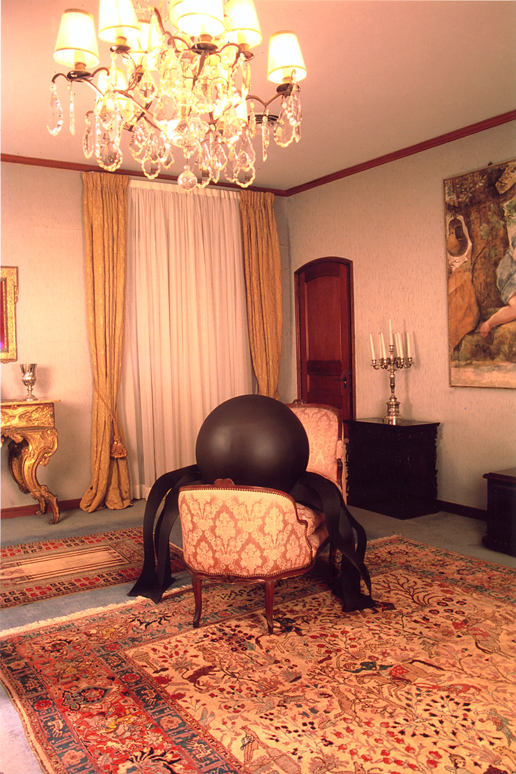
Heleno Bernardi
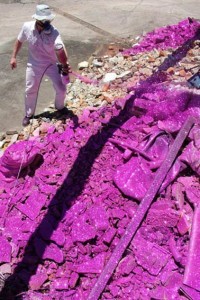
This is a photo of an urban intervention:
Magma (glitter “on demolition”)
I think it talks a lot of my work
Cristina Filipe
Dear Heleno
I was impress by your last installation with the ping pong tables. Impress me the interaction with the people and the plastic visual effect…and the sound!
You told me that for You that piece somehow links to Ultrabarroc subject – I do agree:
First the dialogue. The “tête à tête” between 2 peoples. The changing of ideas, the tensions and the strategies to achieve a certain goal! Plus the connotations with the site where was done the installation at Rio…
Then, for me, the fact that this information arrives at the day I found a possible strategy to my intervention on Ultrabarroc project was quite meaningful.
Has I told you briefly on my last email I was quiet concern about colonizing spaces, about individual attitudes, contamination, tension and interaction.
How can I be Me being You.
The “Nicho” at Ex Tereza, refers to me a shelter, a place of retreat to meditation…a hidden space!
To arrive to a new place and to set up a mirror in order to reflect ourselves it is an egocentric attitude, about our ego and to the idea of feeling protect, of feeling at home…
But behind that mirror I wanted to represent the space from the other, the place of arriving!… and even if it is hidden the space behind that mirror, we can feel it or knowing it through a certain sound…that will come out from that space behind and impose the culture the presence of the other through that…
On my first thought I imagine that the sound will represent You…your voice, your environment – for instance…but considering now this incredible strong and sonorous pin pong piece from you,… I found it extremely interesting to hear that sound once I will be looking at Me on that mirror, Do you understand what I mine? Did you already have record that sound?
The sound – It will bring you through the memory and presence of your work. But also the ping pong game represent a lot about the discussion here thought out this project!
Let me know what you think!
Cristina
Cristina Filipe
Heleno
This picture, to me, says a lot also about reflexion and dialogue.
It is interesting how can you be identified through the things you are looking at!
I like this picture very much because of that paradox.
I just send it has a portrait of myself to the Gray Area organizers.
Hope that it adds something to our dialogue and to this thinking process through out Ultrabarroc trial!
Cristina
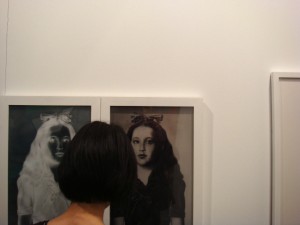
Heleno Bernardi
Dear Cristina,
Olá! You’ve got exactly the spirit of the Ping Pong work. The “tête a tête”, the dialogue, the “descentralization” changing poles, gathering spaces and discovering new routes between people. There is a sense of mirroring: “I am what you see I’m seeing (looking at)”, like the picture that you posted.
So, the idea of the mirror for the nicho at Ex Tereza “sounds” very reflective/reflexive.
However, I’m not sure that I have a (good) sound record of the ping-pong work. I think this noise could not be perceived correctly… But I like very much the idea of the sound behind the mirror, throug the image.
At this moment I can hear a typewritting machine (like an old Remington machine) and… it sounds like someone “spelling” from another time, another space, another world. This sound evokes images with some narrative. The rithm and the power of the typewritting express the emotional spirit of the writer (or more than only one machine?).
I’ve got the daring to say that is possible to know about the content of the “letter” only hearing its sounds… It’s like a mirroring of the subjetc meaning.
What do you think about this? How its sounds for you?
Heleno.
Cristina Filipe
Dear Heleno I am listening to:
A long letter about our past, our history…what are you telling me…what is the story about..who I did hurt when I first arrive?… The wounds…we have open..the walks we have done…everything that happens to us in our previous life…not sure who come first. The space was empty, a lot of trees and sand….sun…and water. The sound of the birds was intense and continue…the colour was…gold? Where am I. Who are you and where I can find you. Let me be You. When I see me I hear you. Your voice comes through the sound of your fingers typping on a old typewriting machine. Where did you found it..? To whom it belongs? Tell me the story …the story of your native world…I miss your past…I miss your treasures…we lost it…but now we found it. It is there hidden behind that mirror I can feel it is inside me…
I see me and I feel you, your world…your deep and profound roots coming into my soul…I am not only me anymore. I can not be only me from that moment I touch your ground…
I can hear the sound of your finger writing on the sand…the silence of your movement echoes on my hear. I hear the sound of your presence…that’s all I can hear from now.
I can hear You. Can you see Me? Can you see my reflex behind that mirror? Listening to the sound of your presence?
C
Cristina Filipe
Dear Heleno
Cícero (António) the Brazilian contemporary poet wrote:
“Guardar uma coisa não é escondê-la ou trancá-la.
em cofre não se guarda coisa alguma.
em cofre perde-se a coisa à vista.
guardar uma coisa é olhá-la, fitá-la, mirá-la por
admirá-la, isto é, iluminá-la ou ser por ela iluminado.
Guardar uma coisa é vigiá-la, isto é, fazer vigília por ela,
isto é, velar por ela, isto é, estar acordado por ela,
isto é, estar por ela ou ser por ela.
Por isso melhor se guarda um vôo de um pássaro
do que um pássaro sem vôos.
Por isso se escreve, por isso se diz, por isso se publica,
por isso se declara e declama um poema:
Para guardá-lo:
para que ele, por sua vez, guarde o que guarda:
Guarde o que quer que guarda um poema:
Por isso o lance do poema:
Por guardar-se o que se quer guardar”
I thought about this poem when you ask me what is our tresure today…about our necessity to express it in order to be conscious of it.
Some how what we want is to keep our treasure beyond that mirror. As Cicero’s says in his poem, to keep is to look after it, is to work about it, to mention it…so our precious “thing” which I do not know exactly what it is, is the fact that we are conscious about it and we want to make something with it…may be our treasure is our dialogue, it is exactly our encounter on the 22nd April…curiously also the day when I was born 465 years later.
Yes, I have heard about the mirrors gift, but I haven’t thought…and I found it amazing and also extremely interesting the unconscious coincidence about proposing to use a mirror in our installation…who makes it even more meaningful…and, of course, has you said it is very interesting to work about that with a critical and contemporary vision.
The ambiguity of the mirror…that first was gifted as a powerful object, almost a magic tool to conquest the natives…is absolutely about to exert power giving to the other an artefact that makes him believe that is stronger because now his able to see his own image. But this poisonet present it is really about to colonized, to seduce, to impose power, contaminating…
But, still, the inner voice, the soul, is more important that to see and to be conscious of the reflex of our self’s in a certain mirror (remind Narciso myth),…that’s why in this little niche, at ex-Teresa, even if I will be able to see myself reflected on that mirror, even if that mirror will be a metaphor of the ones who pretend to be safe and stronger, the treasure is the soul of the real one who belongs to that earth. So the treasure is the “alma”, the “truth”, the inner us. How can you materialize “alma”. How can you go back to those indigenes…how can we feel them?
Silence…is one of the stronger tools of communication. How can we express silence? Wisdom?
I do not have a final vision yet I do believe and feel we are close…to materialise is for me one of the most difficult tasks, I found it extremely difficult to give shape to a certain thought or idea…I believe that we always fail when we do it and we always work out about the same because we are never satisfied with what we get so far…
What I like about the work I have seen from you, so far, is the aspect that there is not a predicted shape, or form…those last pieces you have shown me they are gestures, simple actions that translate an idea through that performative gesture.
Myself I have been working through that. How a gesture could translate a piece. I use my body to demonstrate that, and I like the mystery of that gesture trough that small action…
So, for our intervention in Ex Teresa in Mexico I am also interested into the body presence through small gestures.. And how these translates our idea….that’s why the mirror and that’s why the voice, the sound, the memory of a certain gesture or action…as we have talked before…for instance, the ping pong sound , the typing machine…both sounds created by body actions.
I believe we should keep on this stage of mind…what ever will be our treasure beyond… it should be translate it with a body gesture…even if just breathing. How interesting could be to see Me and to listening to Your breathing. To synchronized our breathing…for instance…
I am conscious that we have difficulties to generate sound, but maybe we found a solution. I haven’t got yet the time to investigate better this technical problem…but it can also be something else that it will bring your presence: a certain smell, a strong odour…a texture…something really that takes you beyond that mirror, something that will remove you from your reflex and makes you strongly conscientious and curious of the importance of the presence of the other.
I live you with the last 3 paragraphs of Pero Vaz de Caminho letter:
Esta terra, Senhor, parece-me que, da ponta que mais contra o sul vimos, até à outra ponta que contra o norte vem, de que nós deste porto houvemos vista, será tamanha que haverá nela bem vinte ou vinte e cinco léguas de costa. Traz ao longo do mar em algumas partes grandes barreiras, umas vermelhas, e outras brancas; e a terra de cima toda chã e muito cheia de grandes arvoredos. De ponta a ponta é toda praia… muito chã e muito formosa. Pelo sertão nos pareceu, vista do mar, muito grande; porque a estender olhos, não podíamos ver senão terra e arvoredos — terra que nos parecia muito extensa.
Até agora não pudemos saber se há ouro ou prata nela, ou outra coisa de metal, ou ferro; nem lha vimos. Contudo a terra em si é de muito bons ares frescos e temperados como os de Entre-Douro-e- -Minho, porque neste tempo d’agora assim os achávamos como os de lá. Águas são muitas; infinitas. Em tal maneira é graciosa que, querendo-a aproveitar, dar-se-á nela tudo; por causa das águas que tem!
Contudo, o melhor fruto que dela se pode tirar parece-me que será salvar esta gente. E esta deve ser a principal semente que Vossa Alteza em ela deve lançar. E que não houvesse mais do que ter Vossa Alteza aqui esta pousada para essa navegação de Calicute bastava. Quanto mais, disposição para se nela cumprir e fazer o que Vossa Alteza tanto deseja, a saber, acrescentamento da nossa fé!
Cristina
Cristina Filipe
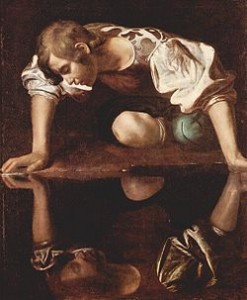 Caravaggio | 1594 – 1596 Caravaggio | 1594 – 1596
Heleno Bernardi
Dear Cristina,
Beyond our changing about mirroring and other possibilities, I’m thinkin about a more delicate relationship between Portugal and Brazil. “Into” the colonizazion and indepence process, a lot of things ocurred and a lot of conflits (wars) too. Naturally, this happen until now. I think the continuous conflits (“stress”) are linked to an emotional/lovely idea: “We only insuflate problems discution with those we love”.
The mirror can access our personal wars: is like the world see us.
Well, the sounds I’m dreaming are something warlike.
Please, listen…
Cristina Filipe
Dear Heleno
The sound is perfect. The intensity, the tension and the narrative that it describes is absolutely adequate to the context of our site specific.
Your sound it´s watching me. And, through the sound I listen to Your presence. This tangent line, represented by the mirror creates the space between My existence and Your existence.
What it’s strong my presence?… The conscious of My presence through out my reflex on the mirror? Or the military sound from You coming into my direction towards my existence?
In fact that mirror represents that tangent space and the cliché that something really exists behind it or beyond it…the mirror creates exactly that line where you believe you can be safe.
To colonize and to give independency was definitely a tension and warlike moment in the history of Brazil and Portugal. Both moments have created tensions and wounds, always, as you said because there was a lot of passion from the first site…
Heleno Bernardi
Dear Cristina,
finally I think we have our art work!
The mirror, the ocean, your/my reflex, the war, the passion, the sound, the new world, the relationship, the tension… our poetry.
I agree to the title “10:04″. It’s an exactly information, but also emblematic, like the mirroring.
Voilà!!! Chegamos!!!
Bjs,
Heleno.
Heleno Bernardi
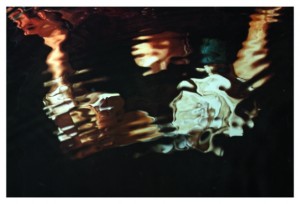
The the ocean,
your/my reflex,
the war,
the warlike sound,
the passion,
the new world,
the relationship,
the tension…
our poetry.
Mirrorsoundspaces.
Cristina Filipe
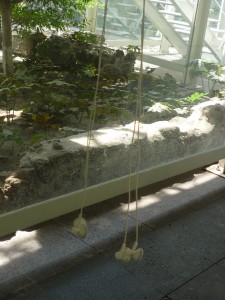 10´04´´
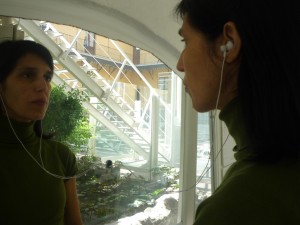 How can I be Me being You?
Cristina Filipe
To arrive at a new place and to set up a mirror in order to reflect oneself is an egocentric attitude, a sense of our own identity and a certain way of feeling protected, of feeling at home…
The mirror – as a metaphor of this encounter – displays my body in the foreign land, confirming that I am there.
What more than a mirror can impose on us our very own presence?
But, behind that mirror, the other’s space is represented: the point of arrival!… and even if it is hidden – we can feel it, or know it, through the sound, which reminds us of the culture and the existence of another…
The pair of head-phones which comes from the space behind the mirror – the colonized space – allows each “colonizer” to see himself or herself and to listen to a “warlike” sound (10’:04’’) which translates the tension of the moment of the encounter between the “colonizers” and the “colonized”.
Just as Narcissus who found his own reflection in a lake, fell in love with it and followed it. Here we too as colonizers feel safer with the presence of our own image in an unknown place.
Is our presence and the way in which we impose ourselves in a new territory enough to say that that place belongs to us? Or is our existence as ephemeral as Narcissus’s in the water of a lake?
A mirage that merely attempts to erase the roots of a place?
This ambiguity of seeing ourselves, and of hearing within us, the voice of another – translates the underlying idea of the theme of our work in this Ultrabarroco project.
I see me and I feel you, your world… your deep and profound roots coming into my soul… I am not only me anymore. I cannot be only me from the moment I touch your ground…
I can hear the sound of your finger writing on the sand… the silence of your movement echoes in my head. I hear the sound of your presence… that’s all I can hear for now.
I can hear You. Can you see Me? Can you see my reflection behind that mirror? Listening to the sound of your presence?
|
|


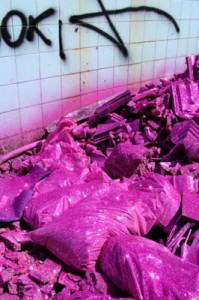

 Caravaggio | 1594 – 1596
Caravaggio | 1594 – 1596




